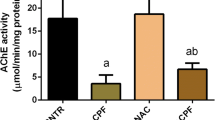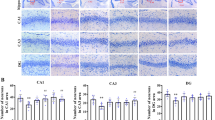Abstract
Paraoxon is the bioactive metabolite of organophosphate (OP) pesticide, parathion. This study aimed to evaluate the expression of apoptosis-related genes and histopathological changes in rat prefrontal cortex following exposure to three different doses of paraoxon. Paraoxon (0.3, 0.7, or 1 mg/kg) or corn oil (vehicle) were intraperitoneally injected to adult male Wistar rats. After 14 or 28 days, mRNA and protein levels of Bax, Bcl-2, and caspase-3 were measured in prefrontal cortex using quantitative reverse transcriptase polymerase chain reaction (qRT-PCR) and western blotting, respectively. In addition, neuronal injury and astrocyte activation were assessed using cresyl violet staining and glial fibrillary acidic protein (GFAP) immune–positive cells, respectively. Treatment with 0.7 and 1 mg/kg of paraoxon increased mRNA and protein levels of Bax and caspase-3 at 14 and 28 days post-exposure, while mRNA and protein levels of Bcl-2 decreased only in 1 mg/kg group after 14 days. Furthermore, a significant decrease in the number of neurons and a significant increase in the number of GFAP-positive cells were observed in rats receiving 0.7 and 1 mg/kg of paraoxon at both time points. Collectively, our results showed that apoptosis is a major mechanism for neuronal damage after exposure to paraoxon. Also, paraoxon-induced neuronal loss was correlated with activation of astrocytes. Since paraoxon-induced neuronal damage is closely related to convulsion, clinical management of convulsion could protect neuronal brain damage.




Similar content being viewed by others
References
Baille V, Clarke PG, Brochier G, Dorandeu F, Verna JM, Four E, Lallement G, Carpentier P (2005) Soman-induced convulsions: the neuropathology revisited. Toxicology 215:1–24
Cerbai F, Lana D, Nosi D, Petkova-Kirova P, Zecchi S, Brothers HM, Wenk GL, Giovannini MG (2012) The neuron-astrocyte-microglia triad in normal brain ageing and in a model of neuroinflammation in the rat hippocampus. PLoS One 7:e45250
Collombet JM (2011) Nerve agent intoxication: recent neuropathophysiological findings and subsequent impact on medical management prospects. Toxicol Appl Pharmacol 255:229–241
Damodaran TV, Patel AG, Greenfield ST, Dressman HK, Lin SM, Abou-Donia MB (2006) Gene expression profiles of the rat brain both immediately and 3 months following acute sarin exposure. Biochem Pharmacol 71:497–520
Elmore S (2007) Apoptosis: a review of programmed cell death. Toxicol Pathol 35:495–516
Harrison PK, Sheridan RD, Green AC, Scott IR, Tattersall JE (2004) A guinea pig hippocampal slice model of organophosphate-induced seizure activity. J Pharmacol Exp Ther 310:678–686
Howard MD, Mirajkar N, Karanth S, Pope CN (2007) Comparative effects of oral chlorpyrifos exposure on cholinesterase activity and muscarinic receptor binding in neonatal and adult rat heart. Toxicology 238:157–165
Hughes EG, Maguire JL, Mcminn MT, Scholz RE, Sutherland ML (2004) Loss of glial fibrillary acidic protein results in decreased glutamate transport and inhibition of PKA-induced EAAT2 cell surface trafficking. Brain Res Mol Brain Res 124:114–123
Jafari M, Salehi M, Asgari A, Ahmadi S, Abbasnezhad M, Hajihoosani R, Hajigholamali M (2012) Effects of paraoxon on serum biochemical parameters and oxidative stress induction in various tissues of Wistar and Norway rats. Environ Toxicol Pharmacol 34:876–887
Kang WH, Simon MJ, Gao S, Banta S, Morrison B 3rd (2011) Attenuation of astrocyte activation by TAT-mediated delivery of a peptide JNK inhibitor. J Neurotrauma 28:1219–1228
Karimi S, Jahanshahi M, Golalipour MJ (2014) The effect of MDMA-induced anxiety on neuronal apoptosis in adult male rats’ hippocampus. Folia Biol (Praha) 60:187–191
Kassa J, Pecka M, Tichy M, Bajgar J, Koupilova M, Herink J, Krocova Z (2001) Toxic effects of sarin in rats at three months following single or repeated low-level inhalation exposure. Pharmacol Toxicol 88:209–212
Lazar S, Egoz I, Brandeis R, Chapman S, Bloch-Shilderman E, Grauer E (2016) Propagation of damage in the rat brain following sarin exposure: differential progression of early processes. Toxicol Appl Pharmacol 310:87–97
Livak KJ, Schmittgen TD (2001) Analysis of relative gene expression data using real-time quantitative PCR and the 2(-Delta Delta C(T)) method. Methods 25:402–408
Lowthert L, Leffert J, Lin A, Umlauf S, Maloney K, Muralidharan A, Lorberg B, Mane S, Zhao H, Sinha R, Bhagwagar Z, Beech R (2012) Increased ratio of anti-apoptotic to pro-apoptotic Bcl2 gene-family members in lithium-responders one month after treatment initiation. Biol Mood Anxiety Disord 2:15
Mamik MK, Asahchop EL, Chan WF, Zhu Y, Branton WG, Mckenzie BA, Cohen EA, Power C (2016) Insulin treatment prevents neuroinflammation and neuronal injury with restored neurobehavioral function in models of HIV/AIDS neurodegeneration. J Neurosci 36:10683–10695
Mark GP, Rada PV, Shors TJ (1996) Inescapable stress enhances extracellular acetylcholine in the rat hippocampus and prefrontal cortex but not the nucleus accumbens or amygdala. Neuroscience 74:767–774
Mcdonough JH Jr, Shih TM (1997) Neuropharmacological mechanisms of nerve agent-induced seizure and neuropathology. Neurosci Biobehav Rev 21:559–579
Middeldorp J, Hol EM (2011) GFAP in health and disease. Prog Neurobiol 93:421–443
Miyaki K, Nishiwaki Y, Maekawa K, Ogawa Y, Asukai N, Yoshimura K, Etoh N, Matsumoto Y, Kikuchi Y, Kumagai N, Omae K (2005) Effects of sarin on the nervous system of subway workers seven years after the Tokyo subway sarin attack. J Occup Health 47:299–304
Mohammadi M, Zare Z, Allah-Moradi E, Vaezi N, Valadan R, Tehrani M (2016) Alterations in mRNA and protein expression of glutamate transporters in rat hippocampus after paraoxon exposure. Neurotoxicology 57:251–257
Paxinos G, Watson C (2005) The rat brain in stereotaxic coordinates, 5th edn. Elsevier Academic Press, Amsterdam
Racine RJ (1972) Modification of seizure activity by electrical stimulation. II. Motor seizure. Electroencephalogr Clin Neurophysiol 32:281–294
Ramarao G, Bhattacharya BK, Kumar S, Waghmare CK (2011) Gene expression and phosphoprotein profile of certain key neuronal signaling proteins following soman intoxication. Toxicology 290:195–202
Raszewski G, Lemieszek MK, Lukawski K, Juszczak M, Rzeski W (2015) Chlorpyrifos and cypermethrin induce apoptosis in human neuroblastoma cell line SH-SY5Y. Basic Clin Pharmacol Toxicol 116:158–167
Rosman Y, Eisenkraft A, Krivoy A, Schein O, Makarovski I, Shrot S, Ramaty E, Shilderman EB, Kapon J, Gilat E, Kadar T, Maier S, Daniels D, Shneor R, Salomon S, Tamar G, Last D, Mardor Y (2012) Using MRI for the assessment of paraoxon-induced brain damage and efficacy of antidotal treatment. J Appl Toxicol 32:409–416
Sahin S, Gurgen SG, Yazar U, Ince I, Kamasak T, Acar Arslan E, Diler Durgut B, Dilber B, Cansu A (2019) Vitamin D protects against hippocampal apoptosis related with seizures induced by kainic acid and pentylenetetrazol in rats. Epilepsy Res 149:107–116
Saleh AM, Vijayasarathy C, Masoud L, Kumar L, Shahin A, Kambal A (2003) Paraoxon induces apoptosis in EL4 cells via activation of mitochondrial pathways. Toxicol Appl Pharmacol 190:47–57
Shah AA, Treit D (2003) Excitotoxic lesions of the medial prefrontal cortex attenuate fear responses in the elevated-plus maze, social interaction and shock probe burying tests. Brain Res 969:183–194
Shih TM, Koviak TA, Capacio BR (1991) Anticonvulsants for poisoning by the organophosphorus compound soman: pharmacological mechanisms. Neurosci Biobehav Rev 15:349–362
Slotkin TA, Seidler FJ (2012) Developmental neurotoxicity of organophosphates targets cell cycle and apoptosis, revealed by transcriptional profiles in vivo and in vitro. Neurotoxicol Teratol 34:232–241
Sofroniew MV (2005) Reactive astrocytes in neural repair and protection. Neuroscientist 11:400–407
Zare Z, Tehrani M, Rezaei N, Dana Ghalebarzand B, Mohammadi M (2019) Anxiolytic activity of paraoxon is associated with alterations in rat brain glutamatergic system. Neurotoxicol Teratol 71:32–40
Zimmer LA, Ennis M, Shipley MT (1997) Soman-induced seizures rapidly activate astrocytes and microglia in discrete brain regions. J Comp Neurol 378:482–492
Funding
This work was financially supported by the Molecular and Cell Biology Research Center of Mazandaran University of Medical Sciences (7181).
Author information
Authors and Affiliations
Corresponding author
Ethics declarations
All animal experiments were approved by the Ethical Committee of the Mazandaran University of Medical Sciences, Sari, Iran (IR.MAZUMS.REC.96.7181).
Conflict of Interest
The authors declare that they have no conflicts of interest.
Additional information
Publisher’s Note
Springer Nature remains neutral with regard to jurisdictional claims in published maps and institutional affiliations.
Rights and permissions
About this article
Cite this article
Zare, Z., Tehrani, M., Zarbakhsh, S. et al. Effects of Paraoxon Exposure on Expression of Apoptosis-Related Genes, Neuronal Survival, and Astrocyte Activation in Rat Prefrontal Cortex. Neurotox Res 37, 356–365 (2020). https://doi.org/10.1007/s12640-019-00106-x
Received:
Revised:
Accepted:
Published:
Issue Date:
DOI: https://doi.org/10.1007/s12640-019-00106-x




